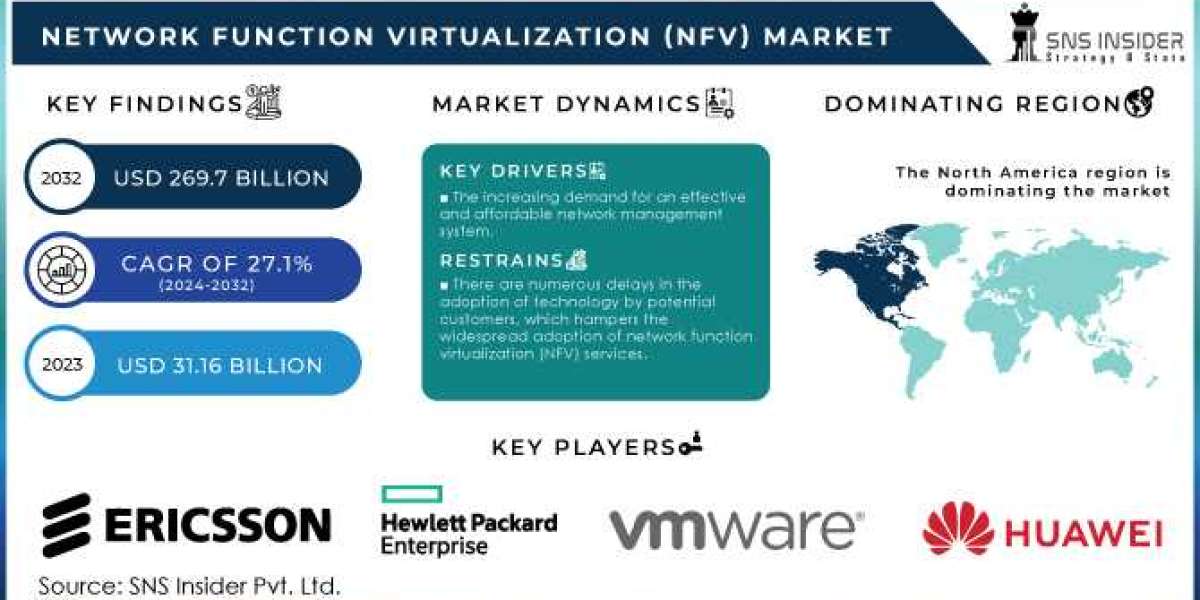Network Function Virtualization (NFV) Market research is a valuable source of advice and information as it contains important information about global business. The research report includes a quantitative analysis of various aspects that have influenced the growth of the industry, such as country, supplier, market shape and size, and market characteristics. This study analyzes historical and forecast data to calculate the total market size based on global conditions. Tables and diagrams containing important data about the state of the industry are included in the overall business overview, along with tips and analysis for companies and consumers interested in the market.
Download Sample Copy of this Report: https://www.snsinsider.com/sample-request/1389
Network Function Virtualization (NFV) Market Key Players:
- Ericsson AB
- Hewlett Packard Enterprise
- VMware Inc.
- Nokia Corporation
- Huawei Technologies
- 6WIND
- A10 Networks
- Affirmed Networks
- Allot Communications
- Amdocs
- others
The Network Function Virtualization (NFV) market is rapidly transforming the telecommunications landscape by enabling service providers to decouple network functions from proprietary hardware, thereby enhancing flexibility and scalability. NFV allows operators to virtualize traditional network appliances, such as firewalls, load balancers, and routers, and deploy them on standard servers in a cloud environment.
Primary and secondary procedures, approved research methods and services are crucial for Network Function Virtualization (NFV) Market research. The report covers all key market drivers and prospects, market constraints and their main competitors, company profile and general strategies to gain presence in the local and global level. This study looks at several countries to provide a qualitative and quantitative assessment of the world economy over the forecast period.
Market Segmentation
By Components
- Solutions
- Orchestration and Automation
- Services
By Virtualized Network Functions
- Compute
- Storage
- Network
By Applications
- Virtual Appliance
- Core Network
By End Users:
- Service Providers
- Data Centers
- Enterprises
- Banking, Financial Services, and Insurance
- Healthcare
- Retail
- Manufacturing
- Government and Defense
- Education
- IT-enabled Services
- Others
By Enterprise Size:
- SMEs
- Large enterprises
Browse Complete Report: https://www.snsinsider.com/reports/network-function-virtualization-market-1389
This Network Function Virtualization (NFV) Market research includes a detailed survey of vendors in the global market, along with an accurate analysis of the vendor market to determine the size of the market. The survey provides an overview of the market segments of the target sector and the many growth prospects that the sector faces. Buyers looking to increase their market share in recent and future business situations can benefit significantly from Network Function Virtualization (NFV) Market research.
Regional Developments
This study looks at current trends in these areas and the different options available to service providers worldwide. In a highly competitive environment, a global survey of the Network Function Virtualization (NFV) Market identifies all the key players operating in the automotive hose market and ranks them based on company strengths and products. The regions covered in this research report include Europe, North America, South America, Asia Pacific and others.
Competitive Outlook
This study examines the importance and predictive evidence of the field and its aspects. The report also includes information on the major global industry players in the Network Function Virtualization (NFV) Market including company profile, specifications, product image, capacity, price, cost, and revenue. Market size, major methods of business performance, and company exposure in the region are all covered by market Research. It also includes expert opinions, information about the business environment, and marketing plans.
This Network Function Virtualization (NFV) Market research evaluates the results of internal expert interviews, detailed secondary research, and primary interviews. Each service provider is evaluated using financial analysis, fundamental data, region participation, sales performance, and segment contribution. Upstream industry differences, market segments, business environments, demand developments, and cost and pricing structures are all included in the global study.














